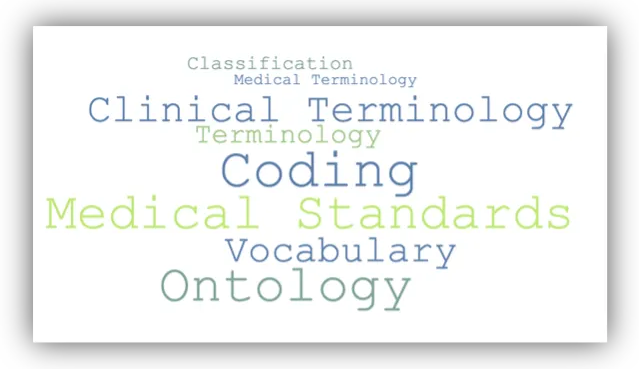Healthcare Terminology Systems Explained (part 1)
Clinical Terminologies and Why They Matter
Humans use words and phrases to describe things they want to talk about in the world. Computers require formal representations of “meaning” in order to convey the same kind of information within and across systems. Healthcare terminologies use codes to represent standard ways of saying things like “heart attack”, “brain MRI”, “aspirin 81 mg oral tablet”, and “basic metabolic panel”. In this article we will be providing a quick introduction into healthcare terminology.
(For a deeper dive, read part two How Clinical Terminologies are Released, part three Common Clinical Terminology Components and part four What Makes Healthcare Data So Difficult?)
Note: As you read this article, if you're interested in browsing healthcare terminologies, exploring how they're stored in a Terminology Server, or learning more about TermHub, visit us at https://www.terminologyhub.com.
Introduction
You will hear a lot of different phrases used when talking about healthcare terminology. Most of these phrases are often used interchangeably such as healthcare vocabulary, terminology, classification, or ontology. However, they do have their own specific meanings.
Vocabulary describes a collection of words with their meanings. (e.g., Dorland’s Medical Dictionary©)
Terminology is a set of terms that represent a system of concepts, or a set of terms with unique identifiers associated with them. (e.g., LOINC®)
Classifications are used to organize like or related entities into a hierarchical structure. Higher level things are “classes” that group a variety of related meanings together. (e.g., ICD-10-CM) ICD-10-CM for example is characterized by grouping into a particular code set.
Ontology is a vocabulary or terminology that is organized by meaning in such a way to allow for the understanding of descriptive information. It uses assertions of first-order predicate logic to define meanings and their relationships to each other. Ontologies support inference and reasoning. (e.g., SNOMED CT®)
While they are technically different things, most often they are referred to collectively as terminologies. We will use this term throughout this article to represent all these meanings.
Why do Clinical Terminologies Matter?
Terminologies help ensure a more complete, seamless, and reusable flow of information. The main function of a terminology is to describe facts about a patient by using codes to represent the underlying meaning. Some examples of what terminology facilitates the ability to do are:
Enter reusable data: Using a terminology helps to minimize handwriting and free text. Instead, the user can select or search for terms that are backed by a code to populate data within the EHR. By utilizing a terminology to accurately and completely code data at user entry it makes this data more reusable.
Support system-to-system communication: Part of that reusability is supporting the semantic interoperability of data through system-to-system communication. By communicating data that has been coded with standardized terminology the system you are communicating with will be more easily able to interpret that data and use it in the care of patients. Terminology is also used within the messaging standards, like HL7® FHIR® , to represent metadata within a message.
Link to patient safety tools: Additionally, using standard terminologies also allows you to link to patient safety tools (i.e., clinical decision support, treatment protocols, and order sets) that have also been encoded with the same standard terminologies.
Support analytics: Terminologies also allow you to perform powerful analytics (which otherwise wouldn’t be possible without the terminology underlying it). This is especially true for terminologies that are knowledge graphs with a rich set of connections between the various concepts. Similarly, terminologies can augment or enhance AI/ML annotation and model training to improve their generalizability.
These are some of the use cases terminologies support, but not an exhaustive list of what terminologies are used to support. While you can still enter and exchange data without the use of terminologies, it can make the secondary use of that data difficult.
Key US Clinical Terminologies
These are just a few examples of key US terminologies. The landscape goes deep with over 100 terminologies in the Unified Medical Language System (UMLS), a product of the US National Library of Medicine (NLM).
Each terminology best supports a distinct set of cases and different levels of granularity as seen above. How each terminology is implemented within a healthcare system depends on a lot of different factors, such as:
Type of healthcare information system (Electronic Health Record vs Laboratory Information System vs Radiology Information System, etc.)
Clinical domain (Radiology vs Lab)
Legacy implementations (older healthcare information systems built on locally built and/or legacy terminologies)
Interoperability requirements (HL7 standards)
National requirements (US ONC)
While there are 100s of different terminologies with different data structures and release cycles, they do share some common components.
Basic Components of Clinical Terminology
Each terminology has its own unique set of components, that it uses to represent concepts but there are some shared common components.
Unique identifiers are used to represent the concepts contained within each terminology. These unique identifiers are then associated with one or more textual descriptions that are used to describe the concepts.
What are other ways of saying “Terminology”?
Here are some commonly used synonyms and/or related terms for terminology:
Vocabulary
Lexicon
Nomenclature
Glossary
Classification
Taxonomy
Thesaurus
Language
People often adopt one of these terms over another based on what they’ve encountered in discussions, presentations, or published papers. As a result, being familiar with these variations can help expedite focused conversations, especially when interfacing with new teams or stakeholders for the first time.
In future articles we will go into more detail around how terminologies are designed, how they are maintained and how they can be implemented into healthcare information systems.



